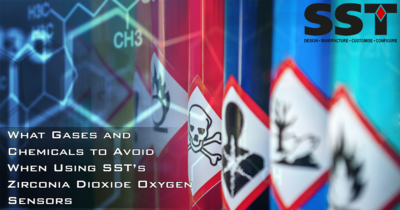
Contact Details:
SST Sensing Ltd
5 Hagmill Crescent
Shawhead Industrial Estate
Coatbridge
Lanarkshire
ML5 4NS
United Kingdom
Tel: +44 (0) 1236 459020
Fax: +44 (0) 1236 459026
Send Enquiry | Company Information

What Gases and Chemicals to Avoid When Using SST’s Zirconia Dioxide Oxygen Sensors
Product News Monday, November 27, 2017: SST Sensing Ltd
Many oxygen sensors have cross sensitivity issues associated with them therefore it is important to know the root cause of the cross sensitivity in order to avoid environments that may pollute your zirconia dioxide oxygen sensor.
There are specific gases and chemicals that have a negative influence on SST’s Zirconia Dioxide Oxygen Sensors, particularly on the life of the sensors or on the performance results. In this article, it will detail what gases and chemicals to avoid when using SST’s Zirconia Dioxide Oxygen Sensors.
Combustible Gases Small amounts of combustible gases will be burned at the hot Pt-electrode surfaces or AI2O3 filters of the sensor. In general, combustion will be stoichiometric as long as enough oxygen is available, the sensor will measure the residual oxygen pressure which leads to a measurement error. The sensor is note recommended for use in applications where there are large amounts of combustible gases present and an accurate oxygen measurement is required. Gases investigated by SST are as follows;
H2(Hydrogen) up to 2%; stoichiometric combustion CO (Carbon Monoxide) up to 2%; stoichiometric combustion CH4 (Methane) up to 2.5%; stoichiometric combustion NH3 (Ammonia) up to 1500ppm; stoichiometric combustion
Heavy Metals Vapours from metals such as Zn (Zinc), Cd (Cadmium), Pb (Lead), Bi (Bismuth) will have an effect on the catalytic properties of the Pt-electrodes. Exposing the Zirconia Dioxide Oxygen Sensors to these metal vapours must be avoided.
Halogen And Sulphur Compounds Small amounts (<100ppm) of Halogens and/or Sulphur compounds have no effect on the performance of the zirconia dioxide oxygen sensors. Higher amounts of these gases will, in time, cause readout problems or, especially in condensing environments , corrosion of sensor parts. Gases investigated by SST are listed below;
Halogens, F2 (Fluorine), Cl2 (Chlorine) HCL (Hydrogen Chloride), HF (Hydrogen Fluoride) SO2 (Sulphur Dioxide) H2S (Hydrogen Sulphide) Freon gases CS2 (Carbon Disulfide)
Reducing Atmospheres Long time exposure to reducing atmospheres may in time impair the catalytic effect of the Pt-electrodes and must be avoided. Reducing atmospheres are defined as an atmosphere with very little free oxygen and where combustible gases are present. In this type of atmosphere oxygen is consumed as the combustible gases are burned.
Other Many customers get SST’s Zirconia Dioxide Oxygen Sensors confused with Bosch Lambda oxygen sensors that are mainly used in automotive combustion applications. SST’s oxygen sensors were developed for boiler combustion control applications. Life tests have been performed in;
A laboratory atmosphere Exhaust gases of natural gas fired boilers Exhaust gases of light oil
In summary, SST’s Zirconia Dioxide Oxygen Sensors have cross sensitivity when particular gases, substances and chemicals are present within the atmosphere. In order to get the maximum performance and prolonged lifetime from the zirconia dioxide oxygen sensors, take into consideration all of the information covered in this article.
Please note, these are all the gases, chemicals and substances SST have performed tests in, if the gas that is present within your application environment is not on the list above, we would recommend testing the sensor for a period of time to ensure it works to its maximum potential.
